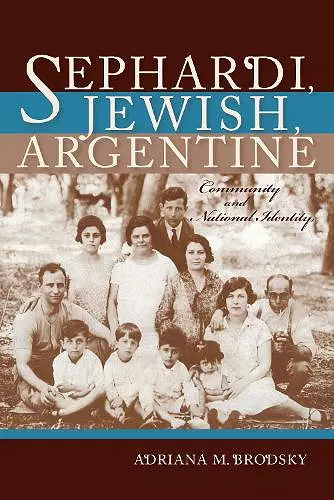Sephardi, Jewish, Argentine
Community and National Identity, 1880-1960
Format:Paperback
Publisher:Indiana University Press
Published:31st Oct '16
Currently unavailable, and unfortunately no date known when it will be back
This paperback is available in another edition too:
- Hardback£70.00(9780253022714)

At the turn of the 20th century, Jews from North Africa and the Middle East were called Turcos ("Turks"), and they were seen as distinct from Ashkenazim, not even identified as Jews. Adriana M. Brodsky follows the history of Sephardim as they arrived in Argentina, created immigrant organizations, founded synagogues and cemeteries, and built strong ties with coreligionists around the country. She theorizes that fragmentation based on areas of origin gave way to the gradual construction of a single Sephardi identity, predicated both on Zionist identification (with the State of Israel) and "national" feelings (for Argentina), and that Sephardi Jews assumed leadership roles in national Jewish organizations once they integrated into the much larger Askenazi community. Rather than assume that Sephardi identity was fixed and unchanging, Brodsky highlights the strategic nature of this identity, constructed both from within the various Sephardi groups and from the outside, and reveals that Jewish identity must be understood as part of the process of becoming Argentine.
Historian Brodsky has written a much-needed monograph on the role of Sephardic Jews in Argentina, and her work is an important contribution to the study of Jews in Latin America overall.
* Choice *In short, the author has made a significant contribution not only to the study of the Sephardim and Jews in Argentina, but also to the study of the minority migrations in the country as a whole and the ethnic histories of the inland provinces of Argentina. This is an important work that hopefully will be the catalyst for further lines of research on the Sephardim, which, as Brodsky says, are no longer invisible in Argentina.
* AJS Review *Overall, Brodsky's analysis of the tensions between assimilation and the maintenance of Jewish identity among the Sephardim in Argentina is a significant contribution to the study of identity. It will be a valuable contribution to all Jewish studies collections.
* Association of Jewish Libraries Reviews *Adriana M. Brodsky's work is a much-needed addition to the growing field of Latin American Jewish studies.
* The Americas *Brodsky has introduced a critical contribution to the study of Jewish Latin America, that highlights Sephardi history and that will continue to be valuable to the sub-discipline and to all scholars attempting to understand the complexity of competing migrant identities.
* Bulletin of Spanish Studies *Brodsky's book is as rich in its sources as it is illuminating in its narrative. It is an excellent contribution to the field of Latin American Jewish studies but is also a necessary read for anyone engaged in diasporic, national, and ethnic studies. Brodsky's narrative is accessible, textured, and vivid, a work of solid scholarship vehemently rooted in both Argentine and Sephardi cultures.
* Hispanic American Historical Review *Bodsky's fascinating study . . . focus[es] on how the Sephardic Jews in Argentina became Argentines, but also, perhaps more significantly, how they 'became Jewish' and came to play their own influential role in the history of Argentine Jewry.
* Bulletin of Latin American ResearISBN: 9780253023032
Dimensions: unknown
Weight: unknown
286 pages